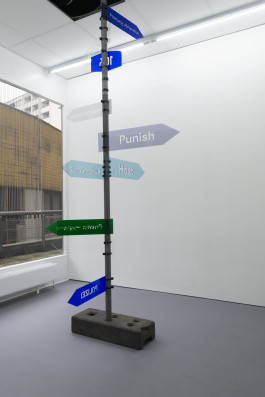
On the first floor of the building complex Zentrum Kreuzberg, Marte Eknæs and Nicolau Vergueiro Punish Fächer. In the cubbyhole nestled between the new Kotti police station (opening a few days before Punish) and the ghost of the 106 Bundesautobahn, Marte and Nicolau perform a clean-up, point and name-call and assort an array of reprimanding tools. Interplaying private and public punishment, civic and domestic hygiene, urban and intimate fantasies, the brushes, punishing instruments and signpost react to their context and confound intruder, helper, lover and oppressor, friend and foe, with (invisible) cues that sometimes are felt but not noticed; like residents at the mercy of an autobahn fantasy.
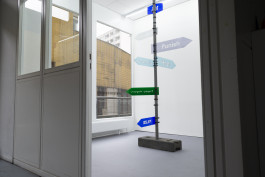
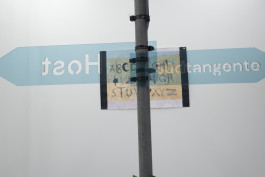

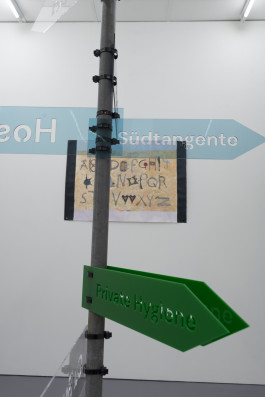
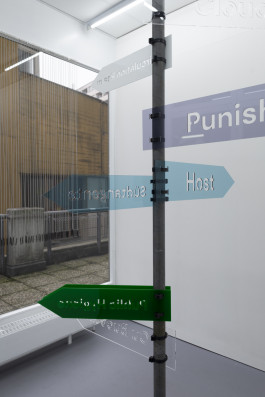
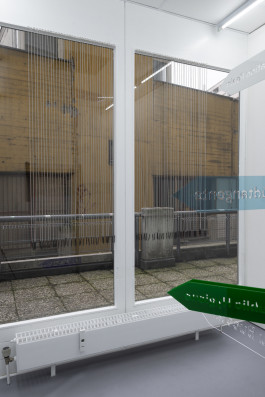
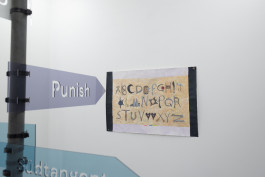
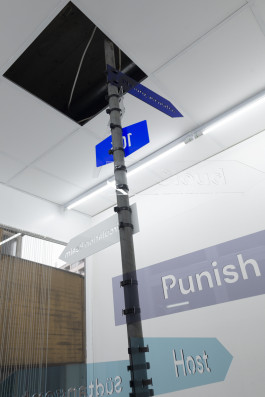
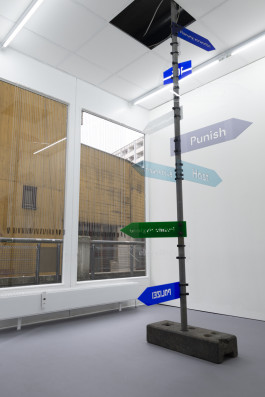
Fächer Signpost, 2023
Marte Eknæs and Nicolau Vergueiro
The 2nd rendition of Signpost, a new series of site-specific sculptures by Eknæs and Vergueiro, locates topics that hover and problematize Fächer’s surrounding area. Zip-tied to a post, some signs are transparent, others copy street signage colors, as they disguise their form to (mis)direct the public’s awareness of their own presence at Fächer.
Two signs point out the pieces in the show: Punish (Alphabet) and Private Hygiene. Other signs: Polizei, 106, Planung Verworfen, Südtangente point to the newly inaugurated police station and the discarded Autobahn and its imagined demarcation. Additional signs refer to other characteristics of the area: Public Hygiene, the title of an older brush piece by Eknæs, takes on a plea for Kotti’s scruffy landscape; Cu Bucetão is a playful and crude nickname Brazilians in Berlin call Kottbusser Tor – a phonetic Portuguese translation meaning ‘asshole big pussy’; and Host conjures the gallery, neighborhood or an unseen force as an invaded or dominating body. Signs Cloud and Wolf 1069b – a newfound exoplanet speculated to have habitable conditions similar to Earth, dislocate awareness beyond the vicinities of Fächer.
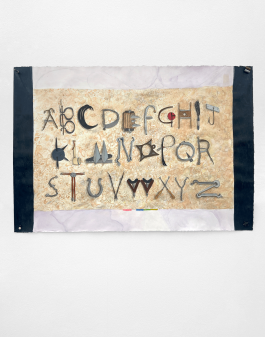
Punish Alphabet, 2022
Nicolau Vergueiro
“The series of alphabet works, a practice Vergueiro started in 2013, play on the act of making meaning with language by dressing up letters in other forms. Each letter in Punish Alphabet is an elaborate instrument of torture, a comment on the English language as a tool of colonialism and Western control, as well as an emotional, if ironic, plea for different tools.” Excerpt of foreword by Svetlana Kitto, from Vergueiro’s Gutterball Surplus exhibition catalogue. “The alphabet is necessarily imperialist, as is everything constructed from it. Stanzas, cadences and verses, of allegories and rhymes, come from the rhythm, the idleness and the violence of the feudal plowed field, where the root of any poem’s sigh (inspired by a most bucolic western coastline) shows itself to be structurally imperialist. Labor and product are garnered from the same lined arrangements on the rectangles of both a plowed field and a poem.” Excerpt from Imperialist Poem by Nicolau Vergueiro.
Private Hygiene, 2023
Marte Eknæs
The piece on the façade window of Fächer is made up of several small brushes hanging from long metal coils, intended to clean the innards of refrigerators. Eknæs’ ongoing ‘brush pieces’, started in 2013, here is downscaled to a more discrete form. Her Public Hygiene 3, 2018, consisted of a 150cm tall, factory bought street cleaning brush hanging from the ceiling of Kölnischer Kunstverein. Like a voluminous and bright chandelier, the piece brought the topic of maintenance of the shared urban landscape into the gallery space. Private Hygiene shifts this insight to domestic maintenance, as the diminutive leashed brushes allude to their snaking their way into inconspicuous orifices to clean invisible spaces. Private Hygiene doubles as a decorative window treatment and as an imminent threat for intrusive sanitation.
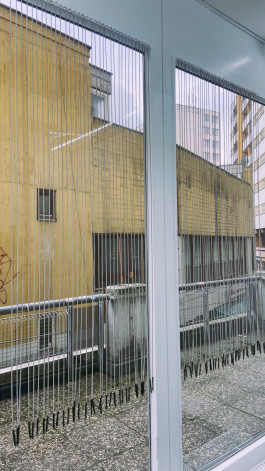
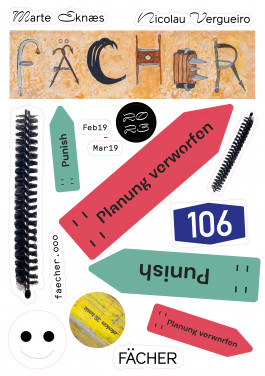
According to the original plans in the Berlin Land Use Plan of 1965, the 106 Bundesautobahn was to form the so-called ‘Südtangente’ to lead Schöneberg via Kreuzberg and Alt-Treptow, to Köpenick. The plans led to evictions, demolitions, vacancies and neglect of the area, and to the construction of the Neues Kreuzberg Zentrum (NKZ) social housing complex, at Kottbusser Tor, built in 1969–1974, projected by architects Werner Jokisch and Johannes Uhl.
As part of the reconstruction of a war-ravaged Berlin, the block of buildings was built with barely any back-facing windows, meant to form a sound barrier against the noisy autobahn, which was never built. These conditions made the neighborhood affordable for (im)migrant workers, artists and youth and the eventual population of a newly integrated city. Houses were squatted and a resistance movement was formed. In spite of the city’s attempts of controlling the neighborhood, Kotti’s residents shaped the area, giving rise to today’s scene and the so-called ‘creative economy’ of Kreuzberg.
Kreuzberg Zentrum’s convoluted existence reflects the ups and downs of Berlin’s post-war inner-city social housing and quality of life, and is a testament of how unrealized ideas, visions and utopias, influence the future and have a profound structural impact on a (given) place.
From Berlin.de:
Police station opening in response to wishes of local residents and businesspeople.
(…) Senator Iris Spranger rejected criticism and hostility from left-wing and extreme left-wing protestors who have been mobilising against the police station (…) and organizing protests since April 2022. The Senator spoke of the litter problem at Kottbusser Tor as well as the area’s dark corners with crimes such as robberies, brawls, pickpocketing, and drug dealing. “Local people are affected by this every day,” said Spranger. She went on to say that a local police station has long been the great desire of local residents and business owners.
From e-journal Berlin Spectator:
Originally the new police station at Kottbusser Tor was supposed to cost 250,000 Euro. The costs have skyrocketed to fourteen times higher than planned. The Senate will have to pay a total of 3,24 million Euro for the project. Senator Iris Spranger says she wants cops “with knowledge of foreign languages” who know the location well. A private security firm is watching the construction of the police station, housed on the first floor of Kreuzberg Zentrum reached via (public) stairs attached to the building. An employee in the smoker’s pub next to the construction site says the new police station would keep them from setting up tables on the long terrace in front of it, in the warm seasons. A representative of another business located in the same building says setting up a police station at Kotti was not a good idea, “because this is the place for people the police are discriminating against”

Punish
Marte Eknæs · · Nicolau Vergueiro
Exhibition
19 February – 2 April 2023
On the first floor of the building complex Zentrum Kreuzberg, Marte Eknæs and Nicolau Vergueiro Punish Fächer. In the cubbyhole nestled between the new Kotti police station (opening a few days before Punish) and the ghost of the 106 Bundesautobahn, Marte and Nicolau perform a clean-up, point and name-call and assort an array of reprimanding tools. Interplaying private and public punishment, civic and domestic hygiene, urban and intimate fantasies, the brushes, punishing instruments and signpost react to their context and confound intruder, helper, lover and oppressor, friend and foe, with (invisible) cues that sometimes are felt but not noticed; like residents at the mercy of an autobahn fantasy.









Fächer Signpost, 2023
Marte Eknæs and Nicolau Vergueiro
The 2nd rendition of Signpost, a new series of site-specific sculptures by Eknæs and Vergueiro, locates topics that hover and problematize Fächer’s surrounding area. Zip-tied to a post, some signs are transparent, others copy street signage colors, as they disguise their form to (mis)direct the public’s awareness of their own presence at Fächer.
Two signs point out the pieces in the show: Punish (Alphabet) and Private Hygiene. Other signs: Polizei, 106, Planung Verworfen, Südtangente point to the newly inaugurated police station and the discarded Autobahn and its imagined demarcation. Additional signs refer to other characteristics of the area: Public Hygiene, the title of an older brush piece by Eknæs, takes on a plea for Kotti’s scruffy landscape; Cu Bucetão is a playful and crude nickname Brazilians in Berlin call Kottbusser Tor – a phonetic Portuguese translation meaning ‘asshole big pussy’; and Host conjures the gallery, neighborhood or an unseen force as an invaded or dominating body. Signs Cloud and Wolf 1069b – a newfound exoplanet speculated to have habitable conditions similar to Earth, dislocate awareness beyond the vicinities of Fächer.

Punish Alphabet, 2022
Nicolau Vergueiro
“The series of alphabet works, a practice Vergueiro started in 2013, play on the act of making meaning with language by dressing up letters in other forms. Each letter in Punish Alphabet is an elaborate instrument of torture, a comment on the English language as a tool of colonialism and Western control, as well as an emotional, if ironic, plea for different tools.” Excerpt of foreword by Svetlana Kitto, from Vergueiro’s Gutterball Surplus exhibition catalogue.
“The alphabet is necessarily imperialist, as is everything constructed from it. Stanzas, cadences and verses, of allegories and rhymes, come from the rhythm, the idleness and the violence of the feudal plowed field, where the root of any poem’s sigh (inspired by a most bucolic western coastline) shows itself to be structurally imperialist. Labor and product are garnered from the same lined arrangements on the rectangles of both a plowed field and a poem.” Excerpt from Imperialist Poem by Nicolau Vergueiro.

Private Hygiene, 2023
Marte Eknæs
The piece on the façade window of Fächer is made up of several small brushes hanging from long metal coils, intended to clean the innards of refrigerators. Eknæs’ ongoing ‘brush pieces’, started in 2013, here is downscaled to a more discrete form. Her Public Hygiene 3, 2018, consisted of a 150cm tall, factory bought street cleaning brush hanging from the ceiling of Kölnischer Kunstverein. Like a voluminous and bright chandelier, the piece brought the topic of maintenance of the shared urban landscape into the gallery space. Private Hygiene shifts this insight to domestic maintenance, as the diminutive leashed brushes allude to their snaking their way into inconspicuous orifices to clean invisible spaces. Private Hygiene doubles as a decorative window treatment and as an imminent threat for intrusive sanitation.

According to the original plans in the Berlin Land Use Plan of 1965, the 106 Bundesautobahn was to form the so-called ‘Südtangente’ to lead Schöneberg via Kreuzberg and Alt-Treptow, to Köpenick. The plans led to evictions, demolitions, vacancies and neglect of the area, and to the construction of the Neues Kreuzberg Zentrum (NKZ) social housing complex, at Kottbusser Tor, built in 1969–1974, projected by architects Werner Jokisch and Johannes Uhl.
As part of the reconstruction of a war-ravaged Berlin, the block of buildings was built with barely any back-facing windows, meant to form a sound barrier against the noisy autobahn, which was never built. These conditions made the neighborhood affordable for (im)migrant workers, artists and youth and the eventual population of a newly integrated city. Houses were squatted and a resistance movement was formed. In spite of the city’s attempts of controlling the neighborhood, Kotti’s residents shaped the area, giving rise to today’s scene and the so-called ‘creative economy’ of Kreuzberg.
Kreuzberg Zentrum’s convoluted existence reflects the ups and downs of Berlin’s post-war inner-city social housing and quality of life, and is a testament of how unrealized ideas, visions and utopias, influence the future and have a profound structural impact on a (given) place.
From Berlin.de:
Police station opening in response to wishes of local residents and businesspeople.
(…) Senator Iris Spranger rejected criticism and hostility from left-wing and extreme left-wing protestors who have been mobilising against the police station (…) and organizing protests since April 2022. The Senator spoke of the litter problem at Kottbusser Tor as well as the area’s dark corners with crimes such as robberies, brawls, pickpocketing, and drug dealing. “Local people are affected by this every day,” said Spranger. She went on to say that a local police station has long been the great desire of local residents and business owners.
From e-journal Berlin Spectator:
Originally the new police station at Kottbusser Tor was supposed to cost 250,000 Euro. The costs have skyrocketed to fourteen times higher than planned. The Senate will have to pay a total of 3,24 million Euro for the project. Senator Iris Spranger says she wants cops “with knowledge of foreign languages” who know the location well. A private security firm is watching the construction of the police station, housed on the first floor of Kreuzberg Zentrum reached via (public) stairs attached to the building. An employee in the smoker’s pub next to the construction site says the new police station would keep them from setting up tables on the long terrace in front of it, in the warm seasons. A representative of another business located in the same building says setting up a police station at Kotti was not a good idea, “because this is the place for people the police are discriminating against”